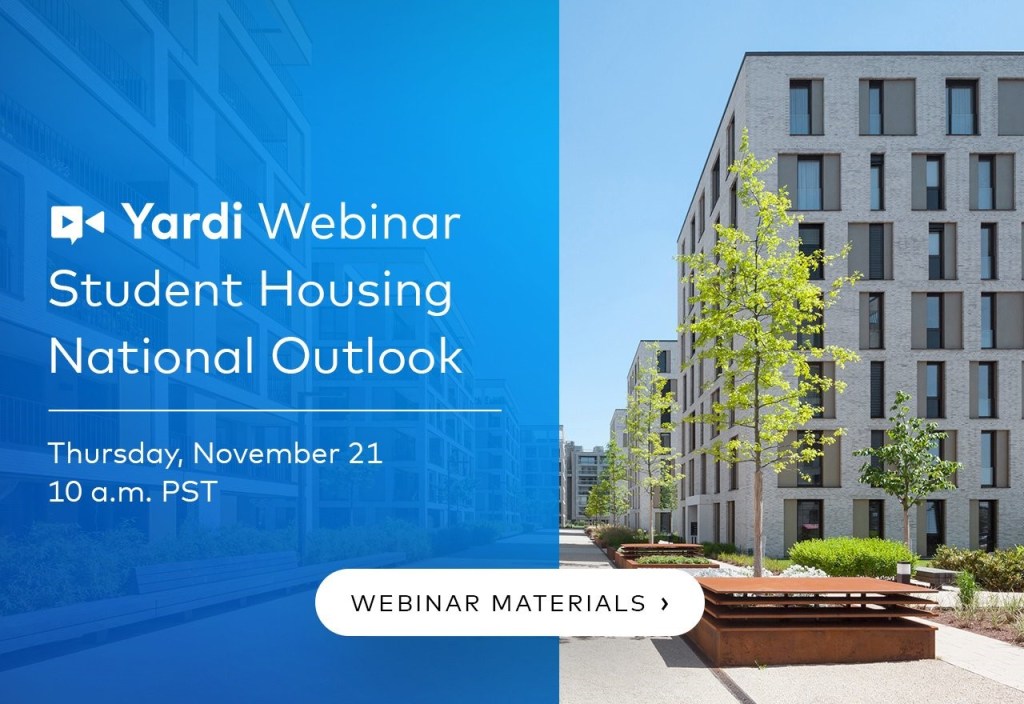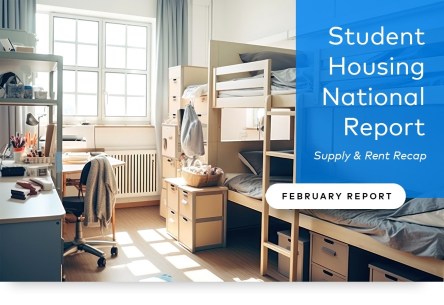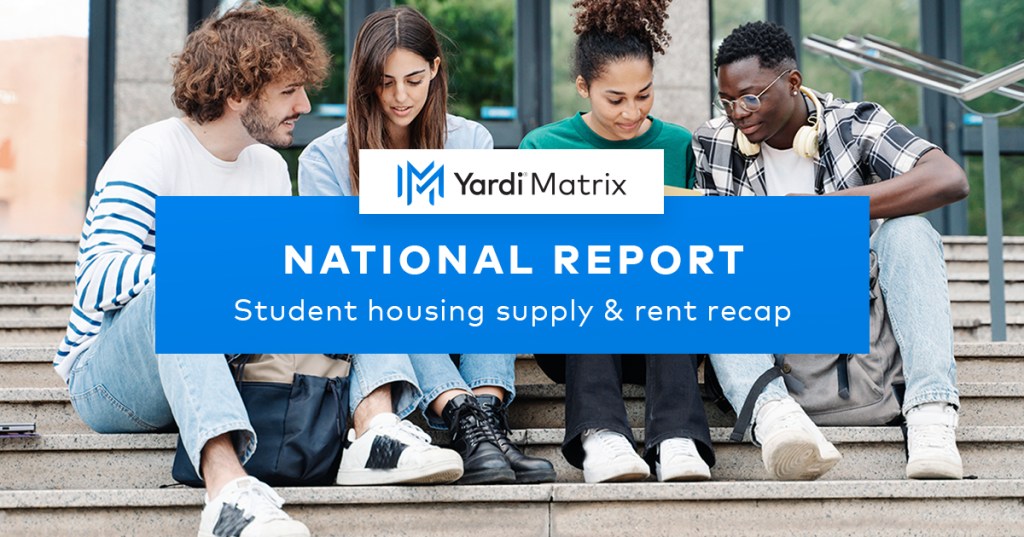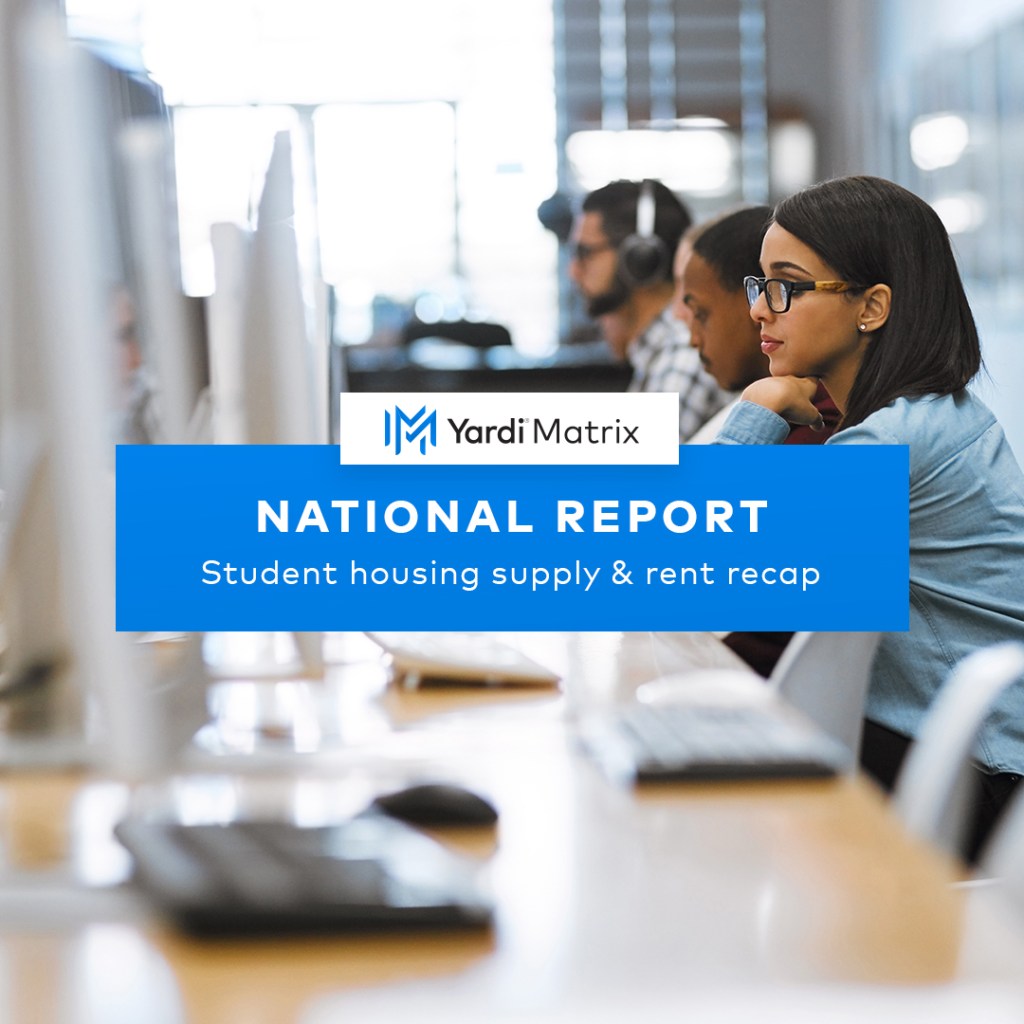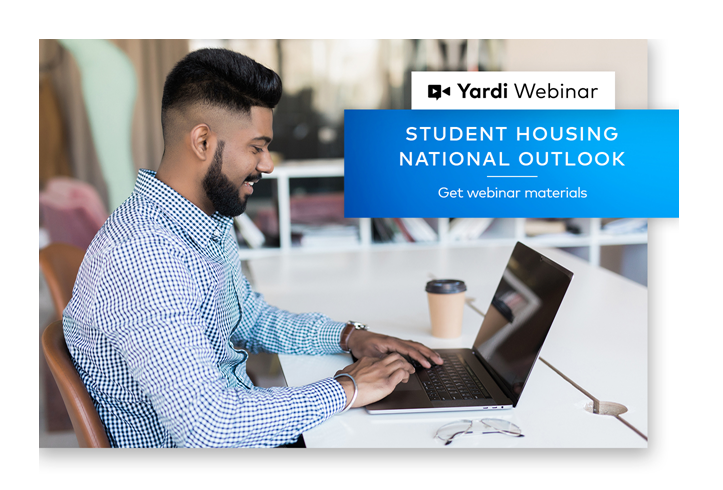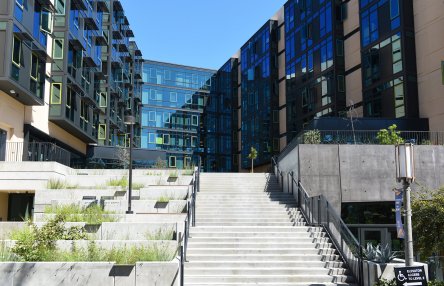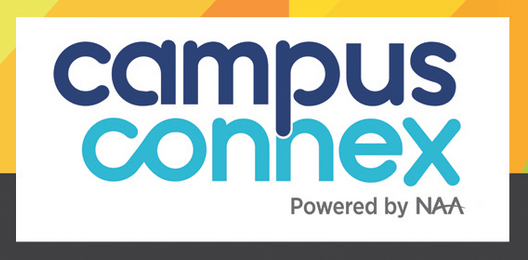The student housing market is showing promising signs as it heads into the very early days of a new leasing season. Despite some challenges, the outlook remains positive, according to the latest webinar on the sector from Yardi Matrix. (View recording and other materials here.) Student housing continues to see solid demand and a few market adjustments should benefit the sector in the medium term. Yardi Matrix tracks the performance of 1.15 million student housing beds at over 2500 U.S. universities to analyze the performance of the student housing market. Let’s dive into some of the key points shared by Tyson Huebner, Director of Research for Yardi Matrix, which explore current state of the student housing market and actionable investment insights. Rent Growth Trends Huebner kicked off the discussion with an optimistic view of the student housing sector, driven by early enrollment data from around half of the Yardi 200 markets. While student housing occupancy has dipped slightly from last year’s 95.4 percent to 93.9 percent, it still reflects strong demand, especially when compared to the pre-pandemic occupancy levels of 96.1 percent. The decrease in occupancy is attributed to a few underperforming markets, but overall, the demand remains robust. Rent growth in the student housing sector has moderated slightly but still averaged a healthy 6% during the leasing season, down from the previous year. This deceleration is partly due to the slower growth in the broader multifamily sector, which has influenced student housing. However, there are still several markets showing exceptional rent growth, highlighting the importance of understanding local market dynamics. As with any cyclical industry, volatility remains a key characteristic of the student housing market. Huebner emphasized the importance of diversifying portfolios, as some markets that were previously underperforming have seen a dramatic turnaround, showcasing the unpredictable nature of supply and demand. The key takeaway here is that market data and deep local knowledge are essential for successful investments in this sector. Insights and Investment Opportunities Looking ahead, Huebner shared several promising investment themes that continue to hold strong: Declining New Deliveries: One factor contributing to the favorable outlook is the reduction in new student housing deliveries, which should help balance supply and demand in the coming years. Diversified Markets: Of the 200 markets tracked, 41 reached 99% occupancy or higher, and 35 saw double-digit rent growth. At the same time, 22 markets had occupancy rates below 85%, and 23 markets experienced rent declines. This highlights the sector’s inherent volatility and the importance of market selection. Overlooked Opportunities: There are still many opportunities in overlooked markets, especially at secondary and tertiary schools that may be under-supplied. Huebner pointed out several key areas for investment, including: 15 primary state schools with no new supply 34 schools with less than 35% of total enrollment housed in student housing 45 schools that have seen significant recent enrollment growth (over 2,000 students) “This sector, even though it’s 20 years old, has been growing. There’s still a lot of growth left in it, not only on the acquisition of getting the on the acquisition side, but in the development business,” said Jeff Adler, vice president of Yardi Matrix. Despite some challenges, there are numerous high-performing markets and overlooked opportunities for investors who understand the volatility and dynamics at play. By leveraging market data and diversifying portfolios, student housing investors can continue to capitalize on the sector’s strengths and navigate its challenges. Yardi Matrix data can help. Learn more...
Preleasing Pops
Matrix Student Housing Update
Student housing’s consistently rising preleasing rate exceeded 50 percent of tracked inventory by the end of January 2024, well ahead of last year’s figure, according to the latest Yardi Matrix National Student Housing Report. Preleasing for the 2024-2025 school year reached 54.5 percent in January, marking a 710-basis-point increase since January 2023. A total of 22 markets were at least 75 percent preleased, while four exceeded the 90 percent rate. A combination of enrollment growth and decreasing new supply is driving the sector’s performance. Asking rates at Yardi 200 schools continued to climb to record highs, hitting $863 per bed in January. However, rent growth decelerated year-over-year, falling to 4.4 percent in January. “Rent growth patterns in student housing vary by market. Some operators push rates hard at the beginning of the leasing season to test the market and ease rent growth later on to fill the remaining beds. Slowing rent growth also reflects the fact that increases were high a year ago,” say Matrix analysts. Yardi Matrix forecasts that 46,285 new beds will deliver in 2024, marking a significant increase from the 35,610 beds delivered in 2023. Investment activity decelerated in 2023, with only 76 student housing properties changing hands. Gain more insight in the new Yardi Matrix National Student Housing Report. Yardi Matrix offers the industry’s most comprehensive market intelligence tool for investment professionals, equity investors, lenders and property managers who underwrite and manage investments in commercial real estate. Yardi Matrix covers multifamily, student housing, vacant land, industrial, office, retail and self storage property types. Email matrix@yardi.com, call 480-663-1149 or visit yardimatrix.com to learn...
Student Housing in Strong Spot
To start the 23/24 School Year
The student housing sector starts the school year in a strong position, as preleasing matches last year’s solid performance and year-over-year rent growth has continually outpaced 2022’s historic growth. Student housing is one of the few real estate sectors to be continually resilient post-pandemic, according to the latest National Student Housing Report from Yardi® Matrix, which is now available for download. You can also join the upcoming Student Housing Webinar with Matrix experts on Oct. 25 and gain more in-depth insight. As of August 2023, 94 percent of beds at Yardi 200 universities were preleased, a 3.3 percent increase from the prior month and 0.2 percent behind August 2022. Rents remained flat in August from July at $845 per bed, but year-over-year rent growth of 6.9 percent in August was still well above the historic average for the sector. “As we enter the 2023-2024 school year, student housing preleasing matches last year’s solid trend and year-over-year rent growth has continually outpaced last year’s historic growth, as well as other property sectors,” say Matrix analysts in the new report. “The sector is in prime position to weather a potential recession, with counter-cyclical demand patterns and solid occupancy and rent growth baked in for the 2023-2024 school year.” Strong fundamentals continue to fuel development, and Matrix projects approximately 40,000 new beds to deliver in fall 2023 at Yardi 200 universities, compared to the 27,000 delivered in fall 2022. Solid preleasing and rent growth suggest that much of the new supply has already been absorbed. Read more findings from the latest student housing report. The student housing data set includes over 2,000 universities and colleges nationwide, including the top 200 investment grade universities across all major collegiate conferences. Known as the “Yardi 200,” it includes all Power 5 conferences as well as Carnegie R1 and R2 universities. Yardi Matrix offers the industry’s most comprehensive market intelligence tool for investment professionals, equity investors, lenders and property managers who underwrite and manage investments in commercial real estate. Yardi Matrix covers multifamily, student housing, vacant land, industrial, office, retail and self storage property types. Email matrix@yardi.com, call 480-663-1149 or visit yardimatrix.com to learn...
Student Housing
Expected to Outperform Again
The student housing industry is set up for another solid performance in 2023 after record returns last year, according to the latest National Student Housing Report from Yardi Matrix. “Momentum is strong heading into the new year, even as the effect of higher interest rates takes hold in the economy and has led multifamily rents to decelerate,” say Matrix experts. “Student housing remains largely unaffected, as the industry typically does better during times of economic volatility.” As of December 2022, 48 percent of beds at Yardi 200 universities were already leased for the fall 2023 school year, representing a new record high for this time of year. Rent growth also remained strong, at 4.7 percent annual growth. “With over eight months to go until the start of the next school year, we anticipate 2023 being another record-breaking year for student housing performance,” states the report. One caveat: highly selective universities with name recognition are maintaining their interest among incoming students, while smaller schools are having more difficulty with enrollment. The slowing economy is having an impact on new student housing supply. With interest rates increasing, the development pipeline is contracting. The development pipeline for Yardi 200 universities (including planned, prospective and under-construction properties) decreased by over 3,000 bedrooms from December to January, representing a 2.6 percent contraction. Gain more insight in the new National Student Housing Report. The student housing data set includes over 2,000 universities and colleges nationwide, including the top 200 investment grade universities across all major collegiate conferences. Known as the “Yardi 200,” it includes all Power 5 conferences as well as Carnegie R1 and R2 universities. Yardi Matrix covers multifamily, student housing, industrial, office and self storage property types. Email matrix@yardi.com, call (480) 663-1149 or visit yardimatrix.com to learn...
Football Fun
For residents and students
American football season is here. Stores and stations are filled with advertisements for local city football teams and the community comes together for Sunday Funday games. The National Football League (NFL) is known all over the world, and even boasts an International Series of five games, three of which are played in London. Let’s not forget about college football, which is also a big deal. Especially if you live in one of the “Power Five” conferences. The Power Five includes the Atlantic Coast Conference (ACC), Big Ten, Pac-12, and the Southeastern Conference (SEC). “Football works as a very effective marketing tool for universities and creates value for student housing properties,” said Jaclyn Fitts, CBRE’s director of national student housing. As a property owner or manager for a multifamily complex or student housing property, how can you market football eagerness and engage with your residents? Here are a few events you can throw this season for your football fan residents. Football season means cooking and getting together with friends. Create that fun atmosphere in your community by hosting football-watch parties in the clubhouse. People bond over football and food. Turn a boring Monday into a fun Monday Night Football watch party with refreshments and treats. Order some pizzas for a fan favorite or get creative with football-themed foods and dips. If you happen to live in one of the Power Five conferences, consider doing an event for two of the rival school games. Especially if this is a student housing property. For example, the University of Texas and the University of Oklahoma are two big rival schools. In the Dallas area, they have their game played during the Texas State Fair in the Cotton Bowl, known as the Red River Showdown. Think about two universities...
Student Housing Tech
WiFi Reigns Supreme
Life for a college student today is much different than it was 20 years ago. Students expect to have the connectivity that they are accustomed to at home. As we dive into student housing tech, one priority is clear: college students demand a fast, reliable WiFi connection. As for Mom and Dad, parents will appreciate the security of electronic locks and cameras, especially when it is their children’s first time off to college. According to a recent article from the National Apartment Association (NAA), for student housing management companies, smart technology offers many advantages: It can alert authorities to danger fasterPeace of mind that no stranger or unauthorized visitor can pick up a key or keycard to get inside the buildingProtect staff by tracking movements in and out of apartmentsSave energy during summer and winter breaks with smart thermostats and alerting if there has been a window left openFree staff from security monitoring to do other tasksDetect leaks in fire and water lines or utility disruptions Security transformation Gone are the days of propping open doors with rocks or losing keys frequently and racking up fines. Smart locks at every entrance mean no more keys or even magnetic cards to carry. Codes are also on the way out since many will share with friends and roommates might not feel comfortable anymore. Bluetooth credentials are the new ways to open doors. Keys, fobs, and codes all can be copied but a Bluetooth credential cannot. Since student housing has a lot more likelihood of damage than your typical multifamily complex, cameras all around the building will also provide security and help staff to see if there was a drunken incident or a pet that is not allowed. Smart doorbells and window security in all units along with a video image of the main entrance intercom on the unit’s touchscreen will benefit for student residents to see who is at the door before admitting them. The window security will alert when a window has been opened and will benefit for winter and summer breaks. Smart locks also allow for contact tracing. “With COVID, once a student or other user reports becoming ill, Servitas LLC can trace his or her movements through the building and alert authorities and other recent users of the same doors and study rooms,” says the NAA article. Smart home shortcomings All the benefits of smart home technology come with some drawbacks as well. Can a building’s network withstand 100% of usage? Students come with myriad WiFi demands such as smartphones and tablets, laptops, TVs, gaming consoles, and more. Student housing property management companies are constantly having to upgrade and maintain bandwidth and equipment, and deal with resident complaints if anything goes down for more than a minute or two. For many years, most companies made eight- to 10-year Internet service agreements; “now I won’t do longer than five years,” says David Braden, Servitas senior VP of operations. Student housing provider Landmark decided a wise choice to handle in-unit tech was a hybrid smart-home hub for each housing unit. The hub handles devices like unit and bedroom locks, door/window open notification, leak detector, thermostat, smart dimmable light switches and video visitor management. Residents can also customize with items like a smart speaker or smart outlets. Apps are managed through a touchscreen. Saving time and money Comprehensive software platforms for leasing, rent pay and maintenance requests are saving student housing staff a lot of time and freeing up extra money for other expenses. Students can log into their accounts to sign leases, and select a perfect roommate with a questionnaire that asks compatibility questions. Chatbots are also becoming more common. Artificial intelligence has improved tremendously and can help those who do not take the time to read the marketing website. “In the first quarter of 2022 alone, the bots responded to 52,000 inquiries, saving the company more than 16,000 staff...
Student Housing
Yardi Matrix Update
The student housing industry continued to break records in the second quarter of 2022, according to the new quarterly National Student Housing Report from Yardi Matrix. An 87.2 percent preleasing rate and rent growth of five percent in June were the highest Matrix researchers have seen thus far for Yardi 200 universities, and transaction activity remains elevated despite rising interest rates. The preleasing rate is 10.1 percent higher than last year and 7.7 percent higher than pre-pandemic 2019. “With a few months to go in the leasing season, we expect Yardi 200 universities to start the fall term with record-breaking occupancy,” state Matrix analysts. The Yardi Matrix student housing data set includes over 2,000 universities and colleges nationwide, including the top 200 investment grade universities across all major collegiate conferences. Known as the “Yardi 200,” it includes all Power 5 conferences as well as Carnegie R1 and R2 universities. “Confidence in the sector abounds as the fall semester approaches, and previous concerns of headwinds have largely been put to rest,” state Matrix analysts in the new report. While some sectors of academia are experiencing postsecondary enrollment declines, the losses have primarily been at community colleges and smaller schools rather than competitive private and public flagship universities. Fears about online learning diverting students from campus have also proven to be unwarranted, as students have a strong preference toward attending college in person. Learn more about the expectations for student housing by downloading the new report. Yardi Matrix covers multifamily, student housing, industrial, office and self storage property types. Email matrix@yardi.com, call (480) 663-1149 or visit yardimatrix.com to learn...
Student Housing
New Yardi Matrix report
The Yardi Matrix Student Housing Report for January offers a glimpse into the health and future of the market. Data reveals solid performance and steady growth, particularly among Big Ten universities. Preleasing Yardi 200 ended the fall 2021 preleasing period on a high note. In September, the figures came in at 94.3%, a 5.2% increase from fall 2020 but 0.4% less below pre-pandemic fall 2019. Data shared by the National Student Clearinghouse Research Center in October 2021 suggests that postsecondary enrollment for the fall 2021 term was 2.6% lower than the previous year and 5.8% below 2019. The nation’s most selective schools and schools in markets with high costs of living have had the strongest leasing thus far. Universities in the Big Ten conference report 40% preleased bedrooms as well as the highest prelease growth of November at 18.7%. Preleasing for the fall 2022 term is already underway. In November, preleasing ended at 26.7%, up from 15.4% from the previous year. Rents The average rent per bedroom was $791 as of December, a 2.2% increase over the previous year and 0.3% over the previous month. That figure marks the highest average rent for off-campus dedicated student housing since the onset of the pandemic. Most notably, the University of California-Riverside reported annual rent growth above 15% and average monthly rent per bedroom at $1,004 as of December. Overall, spring is estimated to bring modest rent growth, particularly favorable for the most selective universities. Only seven of the Yardi 200 universities with four or more properties reported negative annual rent growth. Among them, the University of Alabama reported the steepest decline with -2.7% growth in December. Supply Though housing deliveries declined in 2021, supply is currently on the rise. Yardi 200 delivered about 19,000 bedroom as...
New Semester, New Trends...
Student Housing Fall 2021
Multi-Housing News interviewed Yardi client DTN Management Co. chief operating officer Colin Cronin. Together, they explored trends in student housing and how operators are preparing for the new semester. Snapshot of the Lansing market Cronin reports that the student housing sector in East Lansing remains strong. Enrollment at Michigan State University has increased year-over-year thanks to its appeal with U.S. and international students seeking education at a research-based Big 10 university. “There is uncertainty as to how the supply and demand for student housing will be affected in the near term,” says Cronin. He continues, “We experienced a surge of new renters at the end of the leasing season, when the university closed the dorms for fall 2020. Overall, 2020 turned out to be a great year for off-campus housing at Michigan State University.” DTN meets the changing needs of its clients Pandemic protocols encouraged DTN site staff to implement multiple ways of interacting amongst themselves, with residents and prospects. Cronin explains, “All our leasing, maintenance and resident services were configured to work with each individual customer in a manner in which they were comfortable working with our staff throughout the ever-changing pandemic.” To meet the needs of prospects, DTN adapted virtual tours. This option offered many advantages. During quarantine, prospects could still access video tours even when the offices were closed. When staff returned to the offices with limited capacity for guests, virtual tours provided a live experience for prospects from the comfort and convenience of their homes. Cronin says, “We also leveraged our web presence by enhancing our online experience to better serve remote users. On top of these changes, we focused on both paid search and social media to gain additional market share online.” Paid search options include pay-per-click ads with flexible budgets and...
New Student Housing Standards
For construction and energy
Experiences shape our approach to built spaces. In 1992, Hurricane Andrew irreversibly changed building codes in Gulf states. About 20 years later, Hurricane Sandy prompted code and regulation shifts in New York and mid-Atlantic states. While natural disasters are often the catalysts, the pandemic has made its own mark upon built environments. Student housing experts weigh in on the pandemic-inspired trends that are here to stay. They earn their staying power as they increase convenience, improve functionality and appeal to student demands. Modular construction expedites projects, appeals to students Labor shortage, shelter-in-place mandates and leaps in material costs are just a few causes for delayed project completions in 2020. Projects lag even as campus life returns to normal. Stick-built construction may prove too costly and time consuming to meet projected timelines for future projects. Experts believe modular design will become more mainstream in student housing. “While upfront material costs may be similar to stick-built construction, modular can result in significant time savings, allowing developers to catch up on projects that might have been delayed and deliver new projects faster. This is especially beneficial in markets with high labor costs,” says Kelly Naylor, director of interior design and senior partner at BKV Group. Additionally, modular design places sustainability at the forefront of building. Building construction and operation contribute to roughly 33% of global energy consumption and 39% of greenhouse gas emissions, notes Naylor. Modular construction and light steel framing can reduce a carbon footprint by 20%. Student populations vastly support sustainability measures, and green housing will be well received. Improved ventilation makes a comeback Whether conventional or modular construction, air quality has resurfaced as a top priority.In past decades, an emphasis on tighter building envelopes encouraged greater energy efficiency at the expense of natural ventilation practices. A new program by the U.S. Environmental Protection Agency (EPA) combines the efficiency of ENERGY STAR® with improved air quality through Indoor airPLUS for residential properties. Additional building standards also support improved air quality. HVAC systems containing filters with Minimum Efficiency Reporting Value (MERV) ratings of 13 or higher are among best practices, per the American Society of Heating, Refrigerating and Air-Conditioning Engineers (ASHRAE). To maintain optimal ventilation, the organization recommends the use of CO2 sensors that trigger ventilation purge cycles. Maintaining a higher standard of clean becomes a line item To no one’s surprise, heightened cleanliness standards will remain a priority for the foreseeable future. To promote resident and staff health, student housing providers are implementing hospital-grade electrostatic sprayers to sanitize public surfaces, reports Justin Wybenga, vice president of asset services at GMH Capital Partners. The cleanest surface, of course, is one that no one has to touch. “Many residents are also looking for convenient contactless or concierge-focused amenities,” says Wybenga. “Prior to the pandemic, owners were installing package locker systems and refurbishing buildings with keyless entries, but they have been making significant investments to upgrade amenities with new efficient software like Bluetooth entry for package lockers that has become expected and the norm.” Shared spaces must share the spotlight… Before the pandemic, shared spaces were a staple in new construction. They will continue to be a part of design but play a significantly smaller role, projects Naylor. “For many, studying within their residence or building, rather than on-campus, translated to improved productivity, which they will still want coming out of the pandemic. As designers, we want to facilitate these behaviors by creating spaces within residences and throughout the building where students can focus on academics while feeling connected to the greater community,” she says. Research on the impact of COVID-19 on higher education students that was shared by the University of Nevada concurs. During the pandemic, a higher number of students craved quiet places to study and designated desks. Without access to those resources, they reported “below average satisfaction” with their school and experience. …when students want to share at all Wybenga and his...
Student Housing Slows Down
Sector Outlook Remains Positive
Yardi Matrix vice president Jeff Adler presented a look both forward and back for the student housing sector in a webinar held Wednesday, March 3. (Find the presentation materials and recording here.) Despite the challenges of the pandemic over the last year, the sector has held up relatively well. Rents are still increasing – but just slightly. Year-over-year rent growth was 1.3%, with Class B assets taking a larger hit than Class A or C housing. Adler remains very positive on the student housing space, even though preleasing is currently behind its usual pace for Fall 2021. “We do expect the 2021 term to have a surge in enrollment and preleasing activity, but it will probably come late, in April and May, as the vaccine situation clarifies,” he said. That was just one of many insightful takeaways from the presentation. Yardi Matrix produces a quarterly student housing report that summarizes leasing, rent rate, transactions and other trends. The student housing data set includes over 2,000 universities and colleges nationwide, including the top 200 investment grade universities across all major collegiate conferences. Known as the “Yardi 200,” it includes all Power 5 conferences as well as Carnegie R1 and R2 universities. Schools that have fared best with housing over the last year have been those that are not urban or in states with strict COVID restrictions in place, Adler said. Overall, national university enrollment is down 2.5% this year from a year ago. Currently, preleasing of student housing for Fall 2021 is trending four percent below where it was last year at this time. Preleasing for Fall 2020 ended up five percent behind 2019 numbers. “Large, first tier institutions have done the best, and the top performers are those that have been in states and localities that were open for business (throughout COVID),” said Adler. Universities that have preleasing off to a good start for the upcoming fall term were major public universities in remote areas and some universities near smaller downtowns. That includes schools like Case Western University, the University of New Hampshire-Main Campus and University of Pittsburgh-Pittsburgh campus, which are leading the way as top preleasing performers for Fall 2021. Schools that are falling behind on preleasing include the University of Illinois at Chicago, Brigham Young University and the University of California at Santa Barbara, which are all lagging far from their normal preleasing numbers. As a result of the pandemic, housing providers are seeing higher demand for studios, single bedrooms and bedrooms with their own personal bathroom, Adler said. “Those without bedroom/bathroom parity are struggling (to lease). This may be an issue that continues, where you would have to have very significant discounts to overcome people’s desire not to share a bathroom.” The desire for personal space will also impact on-campus student dorms, which may have to rethink double and triple occupancy situations due to parent and student concerns. “I’m bullish about the whole sector, because dorm capacity just doesn’t work,” Adler said. It also doesn’t seem to matter whether schools are offering fully in-person learning, a hybrid model or all virtual classes. The school simply needs to be open for business in order for student housing demand to remain strong. “Our data showed that they wanted to get out of the house (in 2020) and they did.” Development trends in student housing reflect what life will look like post-pandemic. High performance Wi-Fi, always a must, has become even more important. Apps that allow students to submit maintenance or service requests are trending, as are outdoor/open spaces where students can gather in person. And touchless features, like keycards for building entry or elevator operation, will be more prevalent. Development of new student housing stock is primarily focused in the south and southwestern U.S. and has not been deterred by the pandemic. Investment opportunity in the sector remains strong. Highlights include: Global Student Accommodation Group (GSA) made its...
Student Housing’s Strength
Sector shows resiliency, says Yardi Matrix
Despite massive disruption to in-person learning protocols, demand for off-campus, purpose-built student housing remains strong, according to a webinar and a new bulletin from Yardi Matrix. “College students don’t want to live at home. And their parents seem quite amenable, if financial circumstances allow it, for them not to live at home,” said Jeff Adler, vice president of Yardi Matrix, during the webinar. “There’s been a tremendous amount of noise around the sector, but as it relates to the financial performance of off-campus student housing, it is largely unaffected.” The one key factor is that college or university the students are attending must be offering classes in some capacity, even if they are all online. Need for greater social distance between students in on-campus dormitories have been another helpful nudge. “As long as the school is open somehow, for the dedicated off-campus student housing inventory, (the education format) doesn’t matter,” Adler said. “The off-campus student housing industry has shown itself to be really resilient.” Development pipelines also remain strong, with only two planned projects nationwide falling off the radar in the last quarter. Enrollment trends have favored public universities rather than private schools, indicating that students may be looking for more affordable education alternatives given current economic uncertainty. And off-campus housing options provide a more continuous housing option than on-campus dorms, which are more likely to be subject to closures or status changes. Though college enrollment from international students is down due to travel restrictions, those spots in off-campus housing seem to thus far have been backfilled by American students. One caveat is that these are students whose parents’ economic fortunes have likely not been disrupted by the pandemic. And even if no vaccine is available in spring 2021 as expected, purpose-built student housing is expected to continue to do well. “Even if everything goes horribly wrong (with vaccine development), the fact that this year was as good as it was indicates that as long as the school is open in some fashion, it’s a non-event for the off-campus student housing sector,” Adler said. For the 200 colleges and universities the Matrix team analyzed, preleasing of purpose-built student housing was just 3 percent behind that of 2019. “While demand has been volatile on a university-by-university basis, the willingness and desire for people to congregate near their school will likely help the student housing sector steer through these uncertain times,” states the analysis. Preview new technology for student housing providers at the NMHC/InterFace Student Housing Conference, a virtual event taking place Oct. 19-22. Visit the virtual booth to see how RentCafe Student and Yardi Matrix Student will graduate your leasing and management...
Matrix Studies Up
Student Housing Insights
As colleges and universities announce varied plans to cope with coronavirus this fall, what will be the impact on student housing owners and operators? Some definitive answers were delivered in a July 15 webinar from Yardi Matrix, which also marked the launch of the Yardi Matrix Student data service. Market coverage includes over 2,000 universities and colleges nationwide, including the top 200 investment grade universities across all major collegiate conferences. Reports will also include data into shadow markets, defined as campus-proximate housing that often is rented by college students, though it may not be labeled as dedicated student housing. “The college experience is going to change, and has to change until there is a vaccine in place. This is a fall semester issue and probably into the middle of the spring semester,” Jeff Adler, vice president of Yardi Matrix, told the over 400 attendees at the outset of the online presentation. But that’s not all bad news for student housing, especially for providers with shadow market properties. Of the 200 universities Matrix researchers surveyed for the first study, many have announced plans to reduce dorm capacity levels to accommodate social distancing protocols. This means that more than 60 percent of students attending schools in the Yardi 200 will be living in such shadow market housing – and the total national percentage is higher. “Reduced dorm capacity requirements are a tailwind for off-campus housing,” Adler said. “Is student housing pandemic proof? I would say that it’s pandemic resistant. There is some choppiness expected, but I think overall the sector is going to hang in there.” Long term, the U.S. is expected to see an overall decline in its population of college-age adults, but with more Americans than ever earning four year degrees, attendee figures should...
Student Housing
New product from Yardi Matrix
Already well known in the industry for its dependable, up-to-date and prescient market data, Yardi Matrix will take those skills to school as it begins reporting on the student housing sector. The new research area from Yardi Matrix comes at a particularly opportune time, as student housing owners and investors are navigating an uncertain environment caused by the COVID-19 pandemic. With many colleges and universities still making final decisions about what campus life and enrollment will look like in fall 2020, housing providers are anxious to see how this unprecedented situation will impact revenue streams and investment health. Quarterly Matrix reports focused on the student housing market will be available beginning this summer. Market coverage will include over 2,000 universities and colleges nationwide, including the top 200 investment grade universities across all major collegiate conferences. Reports will also include shadow markets, meaning campus-proximate housing that often is rented by college students, though it may not be categorized as traditional student housing. “We’re looking forward to offering the same comprehensive and future-thinking reporting that we do for the rest of the real estate industry to the student housing sector,” said Jeff Adler, vice president of Yardi Matrix. “We’ve done a deep dive into student housing fundamentals and look forward to sharing our insight with all who are interested.” To that end, the Yardi Matrix team will host a July 15 webinar focused entirely on the student housing market. Attendees can expect to gain insight on the short and long-term impact of COVID-19, best and worst-case scenarios, key indicators for operators and potential areas of opportunity. You can secure your spot in the online session by signing up here. Yardi Matrix offers the industry’s most comprehensive market intelligence tool for investment professionals, equity investors, lenders and property...
What Students Want
NMHC Survey Insights
In the 2020 National Multifamily Housing Council & Kingsley Apartment Resident Preferences survey, 373,000 residents living in 5,336 communities across the U.S. shared their feedback on what renters want. Millennial renters, particularly college-aged adults, expressed their most desirable features in rental housing. Hot topics for the year included parking, sustainability, health, and security. Amenities in these categories interested more than 50% of respondents. Young renters’ top 10 interests Adult renters ages 25 and under were asked which apartment features and community amenities interested them the most. The following 10 features topped their lists: 91% reliable cell reception 88% swimming pool 87% fitness center 85% controlled amenity access 84% secure, self-service, 24/7 package access 82% more storage space in apartment 83% recycling 79% visitor parking 75% common area grills 75% hot tub “The top three categories here– connectivity, swimming pool and fitness center– speak directly to what is top-of-mind for the typical student renter,” says Esther Bonardi, vice president, marketing at Yardi. “Available Wi-Fi to keep up with assignments and stay on top of their studies, a swimming pool that serves as a social oasis to unwind and relax with their friends, and a fitness center to maintain wellness in the midst of their chaotic schedules.” Bonardi adds, “One difference for students is that connectivity is a major factor in Wi-Fi reliability and speeds rather than cell phone reception. Reliable cell phone reception is a standard or necessity rather than an interest.” Reoccurring themes for college-aged renters It’s no surprise that connectivity is a prominent interest of Millennial renters. More than 91% of respondents listed reliable cell reception as a major interest. Nearly 70% were also interested in having Wi-Fi connectivity in common areas. Parking concerns appeared multiple times on the list of young renters’...
IoT in Student Housing
Smart Campuses
The Internet of Things (IoT) has achieved great popularity in the last decade as it increases the comfort and quality of life. A growing number of homes and commercial properties have smart systems controlled by smartphones and microcontrollers through wireless communication techniques. The trend applies to student housing too. A smart strategy can help universities and property managers improve facility management, lower operational costs and enhance student experiences. Millions of students will head to class this fall with tablets and smartphones in tow. All those students are expecting lightning fast Wi-Fi to get the job done on campus and in student housing. IoT is reshaping not only the way students learn, but the way they live. According to Securedge Networks, by 2020 more than $1 trillion will be spent on IoT devices for college campuses across the country. Many universities have implemented smart technology in dorms. For example, Saint Louis University and Arizona State University have installed Amazon Echo Dot devices to help students get information on campus activities. University of Chicago, New York University and University of California, Davis also partnered with Telkonet to help students control the thermostats via a mobile app. According to Telkonet, colleges and universities spend roughly $14 billion on energy expenditures every year. A lot of energy is potentially wasted. Dorm rooms are vacant approximately 70 percent on an average day. IoT as a Service on in Student Housing Most colleges are skeptical when it comes to investing in non-essential technology due to limited budgets. Partnerships can lower project costs. The latest innovation in student housing tech comes from a partnership between Balfour Beatty Campus Solutions and IOTAS (which stands for IoT-as-a-Service). The developer and operator of infrastructure projects for colleges and universities united with the premier smart apartment technology innovator to deliver an integrated smart home experience for students. The partnership targets energy savings, security improvement in residence halls, and marketing to tech-savvy prospects. A few states away, Aspire at Discovery Park offers students the possibility to fully operate and customize their living units via a mobile app. The units feature various smart features including smart lighting, thermostats, outlets, sensors and locks, as well as a full integration of Amazon Echo and Google Assistant. Located in the Discovery Park district of West Lafayette, Indiana, the community ranks as the region’s first property to include a fully-integrated smart home system installed during construction. The system operates in all 835 units. Currently found in multifamily communities across 40 U.S. markets, the IOTAS system connects residents’ and property managers’ authorized devices to smart home features such as: smart switches, outlets, door locks and thermostats door, humidity and motion sensors leak detection ceilings fans window coverings garage door control A Broader Reach with IoT Students use IoT devices to access homework assignments or to access classes remotely via video conferencing. On the other hand, alerts can be sent for those students skipping classes, which benefits school officials to help those who may be struggling academically. Colleges and universities are also trying to reduce traffic congestions, increase road safety—both for drivers and pedestrians—and lower carbon emissions by jumping into the autonomous vehicle cause. These days, the quality of a student housing community is determined by its tech offerings. Families consider Wi-Fi strength, coverage range, and other tech factors when making a decision on student...
TikTok, You Ready?
Social Media for Student Housing
The real estate industry is known to sometimes lag on making use of the latest technology. But since you’re reading this, you are interested in breaking the status quo. TikTok has more installs than Facebook and Instagram combined. It continues to grow rapidly, rewarding early adopters in student housing with an engaged fan base. What is TikTok? TikTok is one of the newer social media platforms that it taking the globe by storm. It’s passed through several naming conventions over time, but TikTok as it is now known hit the market in 2016 and has experienced phenomenal growth ever since. Last year, TikTok became the most-downloaded free app on the Apple App Store in the US and ranked first on Google Play. As of June 2018, TikTok boasted 500 million monthly active users worldwide and about 80 million US downloads. TikTok is a music-centric app that allows users to create videos from 3 seconds to 15 seconds long. Short videos can be strung together to form 60 second segments. The possibilities for viral content are endless. The TikTok demographic is perfect for student housing marketers. About 20 percent of users are under the age of 20. Another 20 percent are ages 20-24. You can influence youth in middle school and high school on a popular and growing platform. Users spend an average of 52 minutes per day on the app. The platform is now monetized. Sponsorships are available. You can also collaborate with “influencers” in simple yet impactful ways, like featuring a college sweatshirt in their video or receiving a shout out. Get creative! How Can TikTok Work for You? TikTok places your content in the hands of your key demographic. Its vertical layout ensures that your content will be seen rather than being...
Student Housing
Update from Rick Graf, Pinnacle CEO
The student housing sector is not the industry’s Sleeping Beauty anymore. The number of students attending universities is growing and this is due mostly to the ease of obtaining loans. As a consequence, the demand for this type of accommodation is surging, which makes the segment appealing to investors. Sales volume almost quadrupled in the last six years, according to Rick Graf, president & CEO of Pinnacle, a Yardi client. According to Yardi Matrix data, Pinnacle Living owns and manages more than 150,000 units of which roughly 18,000 beds at 34 universities across the country, from San Diego to Syracuse, N.Y. In an interview with Multi-Housing News, Graf shares his view on the student housing industry, but also touches on what it takes for a property management company to stay ahead of the game in 2019. Tell us about your view of the multifamily market in general and the student housing sector in particular. What are the main trends? Graf: In general, the multifamily market remains robust. Demand has not lessened due to very strong job growth in nearly every market. With respect to the student housing sector, we continue to see institutional acceptance and desire to expand holdings into this niche subset of multifamily real estate. Transaction volume in student housing topped $11 billion in 2018, up from $3 billion just six years ago. It is important to note that student housing is significantly more management intensive and multifamily investors should be cautious to partner with operators with specific expertise in the nuances needed for success. Could you single out one trend that is gaining popularity in the student housing property management sector? Graf: A sea change has come to student development. While student housing properties rival high-end multifamily properties, the arms race of amenities has turned from wave...
Snapchat for Student Housing
Attract new residents
Of the top five most popular social media apps, Snapchat is the most cryptic to navigate and has the shortest content lifespan. Those are two reasons why young adults love Snapchat, and your student housing community can benefit from loving it, too. So Snapchat…Who Cares? Snapchat doesn’t offer traditional menus for navigation. It’s all about exploration and being in-the-know. The small nuggets of content posted by users can disappear in a fewer than 24 hours. If your student housing brand uses Snapchat, you’re demonstrating that you are relevant, timely, and engaging. Your prowess can place you in front of the eyes of more than 130 million students. About 77 percent of college students use Snapchat and they use it often. Nearly 80 percent of users log in into Snapchat daily. On average, they send 34 snaps each day. With your content in the midst of the action, you can make major impressions. How to Use Snapchat for Student Housing The content in Snapchat has a very short lifespan. As such, your posted content may have a quick expiration date. Use snaps to explore limited-time offers at your property. Maybe you take Snapchatters on a tour of an available unit. Perhaps you use the platform to market a move-in promotion. Snapchat provides an opportunity to highlight content with a short shelf life. Snaps are also great for “setting the scene,” depicting what it’s like to live in your neighborhood. Create short videos and pictures of daily life in the community. Excerpts of a resident pool party show the potential for fun and new friends. Residents enjoying sunset on the rooftop deck show to opportunities to relax amidst a hectic class schedule. Take residents behind the scenes of your community through Snaps. Such snaps can be an interesting way to showcase updates at the community that benefit residents. Think of big ticket items like pool deck upgrades as well as small things like seasonal flower installations. Spice it up with a quick Q&A with the crew. Residents may like getting to know people they may see in their community. Community events are perfect Snapchat fodder, especially when you have high attendance. Take advantage of the “crowd surf” feature, which stitches together multiple snaps recorded by users to create one continuous video at events. Let Users Find You Unlike a Facebook business page, your Snapchat profile provides minimal information about your student housing community. In order for prospects to find you, be sure to use geofilters on some of your posts. This creates a way for viewers to identify your location. When residents see your geofilter, they may be encouraged to use it as well. Geotags quickly and easily broaden your marketing reach. Learn more about smart managing and marketing of your community with the Yardi Student Housing...
Market Sharing
Students + Sharing Economy
They say that sharing is caring. Turns out, sharing is also a great selling point for your student housing community. By integrating the share culture into your student property, you can reap the benefits of this growing economic sector. The sharing economy flourishes worldwide. Its convenience and innovation has won over millions of users. According to PWC research, 83 percent of respondents say the sharing economy is more convenient and efficient than conventional methods of shopping, transportation, and completing tasks. Share practices are already active in your student housing community. Why not capitalize on their success? No- and Low-Cost Solutions You don’t have to spend a lot of money to bring collaborative consumption to your student property. These low-cost solutions are a great place to start: By 2025, the rideshare economy will have an estimated cumulative worth of over $335 billion. Show that you are adapting to the times. Designate an area in your community for rideshare pick-up and drop-off. Mark this area with signage using the rideshare service provider logos, such as Lyft and Uber. If your property has a security gate, place the designated area outside of the gate. This results in fewer guests with gate access codes and shorter lines at the callbox. Make rideshare services easy to access from your property website. True, most users will hail a ride using their smartphone app. The link on your property site, however, shows prospects and residents that you are responsive to their needs and interests. Market the desirability of your location by highlighting food delivery services available in your community. Doordash, Uber Eats, and GrubHub delivery services are popular with young adults. A community share forum creates a sense of cohesion and support within your student housing property. The forum can serve as...
Student Roommates
3 Tips to Benefit the Bottom Line
Many student housing providers offer conflict mitigation as a way to keep the peace between roommates. If you don’t, it’s a good idea to start. Roommate conflicts increase turnover and impact your bottom line. Below are three tips to share with your student residents. They promote clear communication between roommates. More importantly, they cut turnover costs for you and preserve your reputation with prospects. Don’t overtax your friendship. Their message: Your friend may be the most compassionate and forgiving person that you know—don’t take advantage of that. Don’t splurge your rent money on SXSW tickets and then pay late on rent because “she’ll understand.” Certainly don’t eat the last of her Greek yogurt. Strained relationships add stress to living arrangements and can affect your academic performance. Honor your friendship like it matters. Your benefit: Bills are paid on time which is a huge plus in student housing. With better relationships between roommates, there are fewer squabbles that require third party negotiation. Your staff is free to focus on loyalty initiatives and new leases. Learn to talk about money together Their message: You will have to negotiate how much you’re willing to spend each month on cable, internet, and optional fees like trash removal (rather than doing it yourself). When you’re comfortable talking to each other about money upfront, there are fewer chances for spending beyond your roommate’s ability to keep up. You can room together happier, longer. Your benefit: This is especially important when rent does not include utilities and other fees in a single bundle. If one resident is more wasteful than the others due to poor roommate pairing, turnover is inevitable. By having money conversations upfront, roommates can pair with other like-minded (or like-budgeted) individuals and reduce the need to switch roommates....
Reach for New Renters
RentCafe Reach now for student housing
With spring’s college graduations and early summer’s high school graduations behind us, a whole new generation of renters is coming online. These young renters are bringing new life into the rental market, along with their mobile devices and digital expectations. Born in 1995 and after, the first wave of Gen Z are now in their 20s and chances are, they will be searching for rentals with their smartphones. Are you doing everything you can to attract these tech-dependent prospects to your properties? Trends show that Gen Z doesn’t really respond to traditional advertising, but does read reviews and makes decisions based on them. They spend more time on Instagram than Facebook. They are likely to prefer online chat or texting for communication, and expect to pay for things online. That means rent, too. Here’s some great news: the advanced marketing services of RentCafe Reach are now available to our Yardi Voyager Student Housing clients. Now it’s easier than ever to reach more renters who are searching online for a place to live. What is RENTCafé Reach? Managing your student housing marketing, leasing and resident services from one platform that includes dynamic property websites and smart multichannel marketing tools gives you the greatest competitive advantage. With RentCafe Reach, you can take your targeted efforts even further for the best possible results. How renters find vacancies when searching online (the most popular way) often takes multiple paths. RentCafe Reach is comprised of three distinct services—search engine optimization (SEO), search engine marketing (SEM) and promoted internet listings—working together to make sure your communities are positioned to attract more prospects, no matter how renters choose to search. RENTCafé Reach has a team of property marketing experts who are available to help you with search engine optimization (SEO), pay-per-click advertising (PPC) and enhanced online listings. As a certified Google Partner, we’re ready to optimize your search and lead generation efforts. Because RentCafe Reach integrates with RentCafe and Voyager, you get accurate reporting and complete transparency into your data. SEO & PPC Services The RENTCafé Reach digital marketing team is comprised of Google certified experts in both Google AdWords for paid traffic and Google Analytics for organic traffic. This allows us to use Google as a resource to answer questions and identify future opportunities. Our SEO services include: Optimized on-page content, page titles and meta descriptions Off-page optimization, including business citation and brand management Location data management through our partnership with Yext Regular website health audits and maintenance Monthly reporting, service calls and a dedicated account manager Comprehensive reporting to track results Our PPC services include: Strategic PPC advertising tailored to your goals Campaign management by Google AdWords Certified Specialists Ad targeting based on demographics, location, timing and mobility Ad extensions and landing pages to increase conversions Retargeting campaigns that follow engaged prospects Plus, white hat strategies help our clients improve website performance while actively protecting them against black hat techniques that get flagged by search engines. Get Ready for Gen Z Learn more about end-to-end student housing property management using our single connected solution. From social media marketing and online screening and leasing to text rent payments, you can attract, serve and retain quality new renters who improve your bottom...
NAA CampusConnex
Student Housing Recap
Student Housing managers, marketers and exhibitors came together for NAA’s CampusConnex in Orlando, Fl., on February 13-14, 2018 to explore new strategies and get energized to move their careers and businesses forward amidst tech disruption and the latest trends. Yardi returned to this year’s conference as an alliance partner and presenter. “Yardi is excited to be part of CampusConnex, which is a premier opportunity to learn from leaders in the student housing industry and network with peers. Yardi is committed to the industry not only through supporting educational events, but also by offering a single connected solution with mobility for smarter student housing marketing, leasing and management,” said Daniel Campbell, vice president of specialty solutions at Yardi. Conscious Marketing and Simplified Leasing Day one kicked off with an inspiring talk by award-winning marketing innovation expert Afdhel Aziz. Aziz enlightened attendees about how business can be a force for good with more conscious marketing that balances profit with the needs of consumers and communities. Breakout sessions covered a range of topics including partnering with smaller schools and managing online reputation. At the NAA Exposition, more than 100 exhibitors provided a firsthand opportunity to discover the latest innovations in industry-leading products and services designed for student housing businesses. Also part of the Exposition, the Learning Zone offered an intimate setting for valuable education sessions, including a presentation from Yardi’s Jeff Boehm about simplifying the lead-to-lease process by automating every aspect of the leasing lifecycle. And in the 30-minute Speed Networking session, attendees enjoyed quick meetings with multiple industry peers. Coffee and Soapboxes On day two, the first-ever “Coffee on the Quad” kicked off and allowed every student housing geek, technician or innovator to hop up on the soapbox and make their points quickly with a fast-moving slide show. Breakout sessions provided fresh insights on student housing management including approaches to unit renovations, organic search techniques, technology for Generation Z and 40 ways to evaluate operations. The Exposition continued with exhibitor showcases of the best and brightest products and services that promise to move the industry forward. Closing out the conference, humorist and author Jeff Haven dished out compelling insights on how to become the type of leader you want to be, including a roadmap to get there. His focus was on how to communicate more effectively, inspire innovation and create a culture where people are excited to improve. To wrap up two exciting days of learning and networking, there was one thing all attendees already knew how to do: have fun. Yardi hosted an energetic party that featured stilt walkers, a DJ, cigar rollers, an energy and palm reader and a photo area. Stay Connected Learn more about the Yardi Student Housing Suite for a single connected solution with mobile tools and services to better manage and market your student housing properties. And don’t forget to mark your calendars for next year’s event on February...
Facebook Live
5 Tips to Rock Live Video
Video continues to rise to the top of the digital marketing playbook. If you’re skeptical about the power of video, consider that almost 50% of internet users look for videos related to a product or service before visiting a store. And four times as many customers would rather watch a video about a product than read about it. Video content can also improve SEO, increase engagement and boost brand loyalty and awareness. Within the realm of real estate, the industry – from retail to residential to student housing – is finding creative ways to leverage video. What’s clear is video isn’t going anywhere, so it’s time to jump in feet first. Facebook Live offers an interactive, free and highly visible way to engage with an audience. The platform now sees 8 billion average daily video views from 500 million users. With help from social media experts, in-depth tutorials and best practice tips, even the most novice user can become a Facebook Live pro. Here are five tips to rock Facebook Live: Step 1: Ask permission If you plan to live stream other people, ask for permission before you record them. Keep in mind some conferences and venues may have strict no streaming policies. When in doubt, ask. Step 2: Game plan Some questions to inform your live video strategy: Why do you want to do live video? Who are you hoping to reach? What do you want this audience to do? What will you talk about? How long will you go live for? Facebook recommends 10 to 90 minutes, but even 5 minutes is great. Do what feels right for your organization and your viewers. Where will you go live from? Walk the room and consider reserving a spot in front. Minimal background...
Student Housing
Successes Boost Confidence
Just as industry experts thought the interest in student housing may begin to plateau, the prospects for growth are shining brighter. Investors made $1.1 billion in student housing property transactions in the first quarter of 2017, reports CRBE. This figure excludes portfolio deals, which held their own: Q1 ended with the sale of a $1.6 billion portfolio, which is a great start to the year. Local and foreign investors are showing confidence in the student housing sector. Student housing is historically more stable throughout economic fluctuations. There are fewer enrollment surges during times of prosperity and fewer dips in enrollment during challenging times, reports TH Real Estate. Tom Park, Senior Director, Strategy & Research at TH Real Estate, explains: “Rental growth in the sector has proven to be less volatile than that of conventional apartments – partially as a result of the sector being less economically sensitive. Results for some of the largest players in the market show rental growth volatility, as indicated by the standard deviation, was lower than conventional apartments and capital expenditures are in line with those of conventional apartment.” College enrollments have continued to rise since 2008. Most notably, 2014 ushered in $3.5 billion in sales, topped in 2015 with $6 billion and $10 billion in 2016. The consistent growth contributes to the perception that student housing is a recession-resistance sector. Enrollment in and applications for post-graduate programs are also rising. TH Real Estate estimates that about 3 million students enrolled in post-graduated programs in fall 2016. That figure has consistently risen since 2010 when enrollments maxed at about 2.2 million. Post-graduate studies will extend the demand for student housing Though enrollments continue to grow, state budgets for education are shrinking. Public colleges and universities seek out institutional investors and developers...

